Influence of the CAD-CAM Systems on the Marginal Accuracy and Mechanical Properties of Dental Restorations
Abstract
:1. Introduction
2. Materials and Methods
2.1. Model Preparation
2.2. Study Groups Assignment
- -
- Group A: in this group, Cr-Co frameworks were made using a 3-axis milling system. It consists of 9 models.
- -
- Group B: in this group, Cr-Co were made using a 5-axis milling system. 9 models make up this group.
2.3. Structure Design and CAD-CAM Manufacturing
- Thickness of 0.5 mm around the entire outline of the structure.
- Pontic in FPD position number 15, with a convex shape on its cervical surface and 1 mm away from the edentulous crest.
- Application of a space of 50 µm on the dies to 1mm from the location of the finishing line.
- Milling strategies for the machines responsible for milling the structures were established with Hyperdent CAM software (Technology GmbH, Berlin, Germany). Subsequently, the structures were milled with the corresponding milling machines, depending on the group assigned to each model:
- 3-axis machine (NX Mach, Siemens, Plano, TX, USA).
- 5-axis machine (Zfx-Sauer 10, Zimmer, Dachau, Germany).
2.4. Roughness
2.5. Surface Morphology and Marginal Gap Determination
2.6. Mechanical Tests
2.7. Statistical Analysis
3. Results and Discussion
4. Conclusions
Author Contributions
Funding
Acknowledgments
Conflicts of Interest
References
- Mormann, W.H.; Brandestini, M.; Lutz, F. The Cerec system: Computer-assisted preparation of direct ceramic inlays in 1 setting. Quintessenz 1987, 38, 457–470. [Google Scholar] [PubMed]
- Sannino, G.; Germano, F.; Arcuri, L.; Bigelli, E.; Arcuri, C.; Barlattani, A. CEREC CAD-CAM Chairside System. Oral Implantol. 2015, 7, 57–70. [Google Scholar]
- Mangano, F.; Gandolfi, A.; Luongo, G.; Logozzo, S. Intraoral scanners in dentistry: A review of the current literature. BMC Oral Health 2017, 17, 149. [Google Scholar] [CrossRef] [PubMed] [Green Version]
- Tapie, L.; Lebon, N.; Mawussi, B.; Fron Chabouis, H.; Duret, F.; Attal, J.P. Understanding dental CAD-CAM for restorations—The digital workflow from a mechanical engineering viewpoint. Int. J. Comput. Dent. 2015, 18, 21–44. [Google Scholar] [PubMed]
- Tinschert, J.; Natt, G.; Hassenpflug, S.; Spiekermann, H. Status of current CAD-CAM technology in dental medicine. Int. J. Comput. Dent. 2004, 7, 25–45. [Google Scholar]
- Rodrigues, S.A.; Presotto, A.G.C.; Barão, V.A.R.; Consani, R.L.X.; Nóbilo, M.A.A.; Mesquita, M.F. The role of welding techniques in the biomechanical behavior of implant-supported prostheses. Mater. Sci. Eng. C Mater. Biol. Appl. 2017, 78, 435–442. [Google Scholar] [CrossRef]
- Ortorp, A.; Jönsson, D.; Mouhsen, A.; von Steyern, P.V. The fit of cobalt-chromium three-unit fixed dental prostheses fabricated with four different techniques: A comparative in vitro study. Dent. Mater. 2011, 27, 356–363. [Google Scholar] [CrossRef]
- Koutsoukis, T.; Zinelis, S.; Eliades, G.; Al-Wazzan, K.; Rifaiy, M.A.; Al Jabbari, Y.S. Selective laser melting technique of Co-Cr dental alloys: A review of structure and properties and comparative analysis with other available techniques. J. Prosthodont. 2015, 24, 303–312. [Google Scholar] [CrossRef]
- Lövgren, N.; Roxner, R.; Klemendz, S.; Larsson, C. Effect of production method on surface roughness, marginal and internal fit, and retention of cobalt-chromium single crowns. J. Prosthet. Dent. 2017, 118, 95–101. [Google Scholar] [CrossRef] [Green Version]
- Rekow, E.D. Dental CAD-CAM systems. What is the state of the art? J. Am. Dent. Assoc. 1991, 122, 42–48. [Google Scholar] [CrossRef] [PubMed]
- Rekow, E.D.; Erdman, A.G.; Riley, D.R.; Klamecki, B. CAD-CAM for dental restorations--some of the curious challenges. IEEE Trans. Biomed. Eng. 1991, 38, 314–318. [Google Scholar] [CrossRef] [PubMed]
- Naert, I.; van Der Donck, A.; Beckers, L. Precision of fit and clinical evaluation of all-ceramic full restorations followed between 0.5 and 5 years. J. Oral Rehabil. 2005, 32, 51–57. [Google Scholar] [CrossRef] [PubMed]
- Rödiger, M.; Schneider, L.; Rinke, S. Influence of Material Selection on the Marginal Accuracy of CAD-CAM-Fabricated Metal- and All-Ceramic Single Crown Copings. Biomed. Res. Int. 2018, 2018, 2143906. [Google Scholar] [CrossRef] [PubMed]
- Sannino, G.; Gloria, F.; Schiavetti, R.; Ottria, L.; Barlattani, A. Dental wings CAD-CAM system precision: An internal and marginal fit sperimental analisys. Oral Implantol. 2009, 2, 11. [Google Scholar]
- Sailer, I.; Makarov, N.A.; Thoma, D.S.; Zwahlen, M.; Pjetursson, B.E. All-ceramic or metal-ceramic tooth-supported fixed dental prostheses (FPDs)? A systematic review of the survival and complication rates. Part I: Single crowns (SCs). Dent. Mater. 2015, 31, 603–623. [Google Scholar] [CrossRef] [Green Version]
- Wolfart, S.; Wegner, S.F.; Al-Halabi, A.; Kern, M. Clinical evaluation of marginal fit of a new experimental all-ceramic system before and after cementation. Int. J. Prosthodont. 2003, 16, 587–592. [Google Scholar]
- Sorensen, S.E.; Larsen, I.B.; Jorgensen, K.D. Gingival and alveolar bone reaction to marginal fit of subgingival crown margins. Scand. J. Dent. Res. 1986, 94, 109–114. [Google Scholar] [CrossRef]
- Felton, D.A.; Kanoy, B.E.; Bayne, S.A.; Wirthman, G.P. Effect of in vivo crown margin discrepancies on periodontal health. J. Prosthet. Dent. 1991, 65, 357–364. [Google Scholar] [CrossRef]
- Jacobs, M.S.; Windeler, A.S. An investigation of dental luting cement solubility as a function of the marginal gap. J. Prosthet. Dent. 1991, 65, 436–442. [Google Scholar] [CrossRef]
- Martins, L.M.; Lorenzoni, F.C.; Melo, A.O.; Silva, L.M.; Oliveira, J.L.; Oliveira, P.C.; Bonfante, G. Internal fit of two all-ceramic systems and metal-ceramic crowns. J. Appl. Oral Sci. 2012, 20, 235–240. [Google Scholar] [CrossRef] [Green Version]
- Kim, K.B.; Kim, J.H.; Kim, W.C.; Kim, H.Y.; Kim, J.H. Evaluation of the marginal and internal gap of metal-ceramic crown fabricated with a selective laser sintering technology: Two- and three-dimensional replica techniques. J. Adv. Prosthodont. 2013, 5, 179–186. [Google Scholar] [CrossRef] [PubMed] [Green Version]
- Christensen, G.J. Marginal fit of gold inlay castings. J. Prosthet. Dent. 1966, 16, 297–305. [Google Scholar] [CrossRef]
- Baldissara, P.; Baldissara, S.; Scotti, R. Reliability of tactile perception using sharp and dull explorers in marginal opening identification. Int. J. Prosthodont. 1998, 2, 591–594. [Google Scholar]
- Jahangiri, L.; Wahlers, C.; Hittelman, E.; Matheson, P. Assessment of sensitivity and specificity of clinical evaluation of cast restoration marginal accuracy compared to stereomicroscopy. J. Prosthet. Dent. 2005, 93, 138–142. [Google Scholar] [CrossRef] [PubMed]
- Tan, P.L.; Gratton, D.G.; Diaz-Arnold, A.M.; Holmes, D.C. An In Vitro comparison of vertical marginal gaps of CAD-CAM titanium and conventional cast restorations. J. Prosthodont. 2008, 17, 378–383. [Google Scholar] [CrossRef] [PubMed]
- Leong, D.; Chai, J.; Lautenschlager, E.; Gilbert, J. Marginal fit of machine-milled titanium and cast titanium single crowns. Int. J. Prosthodont. 1994, 7, 440–447. [Google Scholar]
- Harris, I.R.; Wickens, J.L. A comparison of the fit of spark-eroded titanium copings and cast gold alloy copings. Int. J. Prosthodont. 1994, 7, 348–355. [Google Scholar]
- Valderrama, S.; Van Roekel, N.; Andersson, M.; Goodacre, C.J.; Munoz, C.A. A comparison of the marginal and internal adaptation of titanium and gold-platinum-palladium metal ceramic crowns. Int. J. Prosthodont. 1995, 8, 29–37. [Google Scholar]
- Martinez-Rus, F.; Ferreiroa, A.; Ozcan, M.; Pradies, G. Marginal discrepancy of monolithic and veneered all-ceramic crowns on titanium and zirconia implant abutments before and after adhesive cementation: A scanning electron microscopy analysis. Int. J. Oral Maxillofac. Implant. 2013, 28, 480–487. [Google Scholar] [CrossRef] [Green Version]
- Nedelcu, R.; Olsson, P.; Nyström, I.; Thor, A. Finish line distinctness and accuracy in 7 intraoral scanners versus conventional impression: An in vitro descriptive comparison. BMC Oral Health 2018, 18, 27. [Google Scholar] [CrossRef]
- Aldegheishem, A.; Ioannidis, G.; Att, W.; Petridis, H. Success and survival of various types of all-ceramic single crowns: A critical review and analysis of studies with a mean follow-up of 5 years or longer. Int. J. Prosthodont. 2017, 30, 168–181. [Google Scholar] [CrossRef] [PubMed] [Green Version]
- Rinke, S.; Fornefett, D.; Gersdor, N.; Lange, K.; Roediger, M. Multifactorial analysis of the impact of different manufacturing processes on the marginal t of zirconia copings. Dent. Mater. 2012, 31, 601–609. [Google Scholar] [CrossRef] [PubMed] [Green Version]
- McLean, J.W.; von Fraunhofer, J.A. E Estimation of cement lm thickness by an in vivo technique. Br. Dent. J. 1971, 131, 107–111. [Google Scholar] [CrossRef] [PubMed]
- Contrepois, M.; Soenen, A.; Bartala, M.; Laviole, O. Marginal adaptation of ceramic crowns: A systematic review. J. Prosthet. Dent. 2013, 110, 447–454. [Google Scholar] [CrossRef]
- Cho, S.H.; Schaefer, O.; Thompson, G.A.; Guentsch, A. Comparison of accuracy and reproducibility of casts made by digital and conventional methods. J. Prosthet. Dent. 2015, 113, 310–315. [Google Scholar] [CrossRef] [PubMed] [Green Version]
- Nawafleh, N.A.; Mack, F.; Evans, J.; Mackay, J.; Hatamleh, M.M. Accuracy and reliability of methods to measure marginal adaptation of crowns and FDPs: A literature review. J. Prosthodont. 2013, 22, 419–428. [Google Scholar] [CrossRef] [Green Version]
- Song, T.J.; Known, T.K.; Yang, J.H.; Han, S.H.; Lee, J.B.; Kim, S.H.; Yeo, I.S. Marginal fit of anterior 3-unit fixed partial zirconia restorations using different CAD-CAM systems. J. Adv. Prosthodont. 2013, 5, 219–225. [Google Scholar] [CrossRef]
- Boitelle, P.; Mawussi, B.; Tapie, L.; Fromentin, O. A systematic review of CAD-CAM fit restoration evaluations. J. Oral Rehabil. 2014, 41, 853–874. [Google Scholar] [CrossRef]
- Wiskott, H.W.; Belser, U.C.; Scherrer, S.S. The effect of film thickness and surface texture on the resistance of cemented extra coronal restorations to lateral fatigue loading. Int. J. Prosthodont. 1999, 12, 255–262. [Google Scholar]
- Juntavee, N.; Millstein, P.L. Effect of surface roughness and cement space on crown retention. J. Prosthet. Dent. 1992, 68, 482–486. [Google Scholar] [CrossRef]
- Bosch, G.; Ender, A.; Mehl, A. A 3-dimensional accuracy analysis of chairside CAD-CAM milling processes. J. Prosthet. Dent. 2014, 112, 1425–1431. [Google Scholar] [CrossRef] [PubMed] [Green Version]
- Uno, M.; Furuya, M.; Kurachi, M. Manufacture of a titanium full crown by CAD/ CAM: Tolerance of the cutting tool. J. Jpn. Prosthodont. Soc. 2004, 48, 787–796. [Google Scholar] [CrossRef] [PubMed]
- Nakamura, T.; Nonaka, M.; Maruyama, T. In Vitro fitting accuracy of copy-milled alumnia cores and all ceramic crowns. Int. J. Prosthodont. 2000, 13, 189–193. [Google Scholar] [PubMed]
- Borba, M.; Cesar, P.F.; Griggs, J.A.; Della Bona, A. Adaptation of all-ceramic fixed partial dentures. Dent. Mater. 2011, 17, 1119–1123. [Google Scholar] [CrossRef] [PubMed] [Green Version]
- Quintas, A.F.; Oliveira, F.; Bottino, M.A. Vertical marginal discrepancy of ceramics copings with different ceramic materials, finish lines, and luting agents: An in vitro evaluation. J. Prosthet. Dent. 2004, 92, 250–257. [Google Scholar] [CrossRef]
- Holmes, J.R.; Bayne, S.C.; Holland, G.A.; Sulik, W.D. Considerations in measurement of marginal fit. J. Prosthet. Dent. 1989, 62, 405–407. [Google Scholar] [CrossRef]
- Affy, A.; Haney, S.; Verrett, R.; Mansueto, M.; Cray, J.; Johnson, R. Marginal discrepancy of noble-ceramic fixed denatl prosthesis frameworks fabricated by conventional and digital technologies. J Prosthet. Dent 2018, 119, 307. [Google Scholar]
- Sevilla, P.; Aparicio, C.; Planell, J.A.; Gil, F.J. Comparison of the mechanical properties between tantalum and nickel-titanium foams impllant materials for bone ingrowth applications. J. Alloys Compd. 2007, 439, 67–73. [Google Scholar] [CrossRef]
- Zardiackas, L.D.; Parsell, D.E.; Dillon, L.D.; Mitchell, D.W.; Nunnery, L.A.; Poggie, R. Structure, metallurgy, and mechanical properties of a porous tantalum foam. J. Biomed. Mater. Res. 2001, 58, 180–187. [Google Scholar] [CrossRef]
- Manero, J.M.; Gil, F.J.; Padrós, E.; Planell, J.A. Applications of Environmental Scanning Electron Microscopy (ESEM) in Biomaterials Field. Microsc. Res. Tech. 2003, 61, 469–480. [Google Scholar] [CrossRef]
- Aparicio, C.; Gil, F.J.; Fonseca, C.; Barbosa, M.; Planell, J.A. The effect of shot blasting and heat treatment on the fatigue behavior of titanium for dental implant applications. Dent. Mater. 2007, 23, 486–491. [Google Scholar]
- Gil, F.J.; Aparicio, C.; Manero, J.M.; Padrós, A. Influence of the height of the external hexagon and surface treatment on fatigue life of commercially pure titanium dental implants. Int. J. Oral Maxill. Impl. 2009, 24, 583–590. [Google Scholar]
- Gil, F.J.; Herrero, M.; Lázaro, P.; Rios, J.V. Implant-abutment connections: Influence of the design on the microgap and their fatigue and fracture behavior of dental implants. J. Mater. Sci. Mater. Med. 2014, 25, 1825–1830. [Google Scholar] [CrossRef] [PubMed]
- Karl, M.; Rosch, S.; Graef, F.; Taylor, T.D.; Heckmann, S.M. Static implant loading caused by as-cast metal and ceramic-veneered superstructures. J. Prosthet. Dent. 2005, 93, 324–330. [Google Scholar] [CrossRef] [PubMed]
- Akçin, E.T.; Barıs, M.; Güncü, M.; Aktas, G.; Aslan, Y. Effect of manufacturing techniques on the marginal and internal fit of cobalt-chromium implant-supported multiunit frameworks. J. Prosthet. Dent. 2018, 120, 715–720. [Google Scholar]
- Van Noort, R. The future of dental devices is digital. Dent. Mater. 2012, 28, 3–12. [Google Scholar] [CrossRef]
- Kim, K.B.; Kim, W.C.; Kim, H.Y.; Kim, J.H. An evaluation of marginal fit of threeunit fixed dental prostheses fabricated by direct metal laser sintering system. Dent. Mater. 2013, 29, 91–96. [Google Scholar] [CrossRef]
- Inagaki, R.; Kikuchi, M.; Takahashi, M.; Takada, Y.; Sasaki, K. Machinability of an experimental Ti–Ag alloy in terms of tool life in a dental CAD-CAM system. Dent. Mater. J. 2015, 34, 679–685. [Google Scholar] [CrossRef] [Green Version]
- Pompa, G.; Di Carlo, S.; De Angelis, F.; Cristalli, M.P.; Annibali, S. Comparison of conventional methods and laser-assisted rapid prototyping for manufacturing fixed dental prostheses: An in vitro study. Biomed. Res. Int. 2015, 2015, 3180–3197. [Google Scholar] [CrossRef] [Green Version]
- Goldman, M.; Laosonthorn, P.; White, R.R. Microleakageefull crowns and the dental pulp. J. Endod. 1992, 18, 473–475. [Google Scholar] [CrossRef]

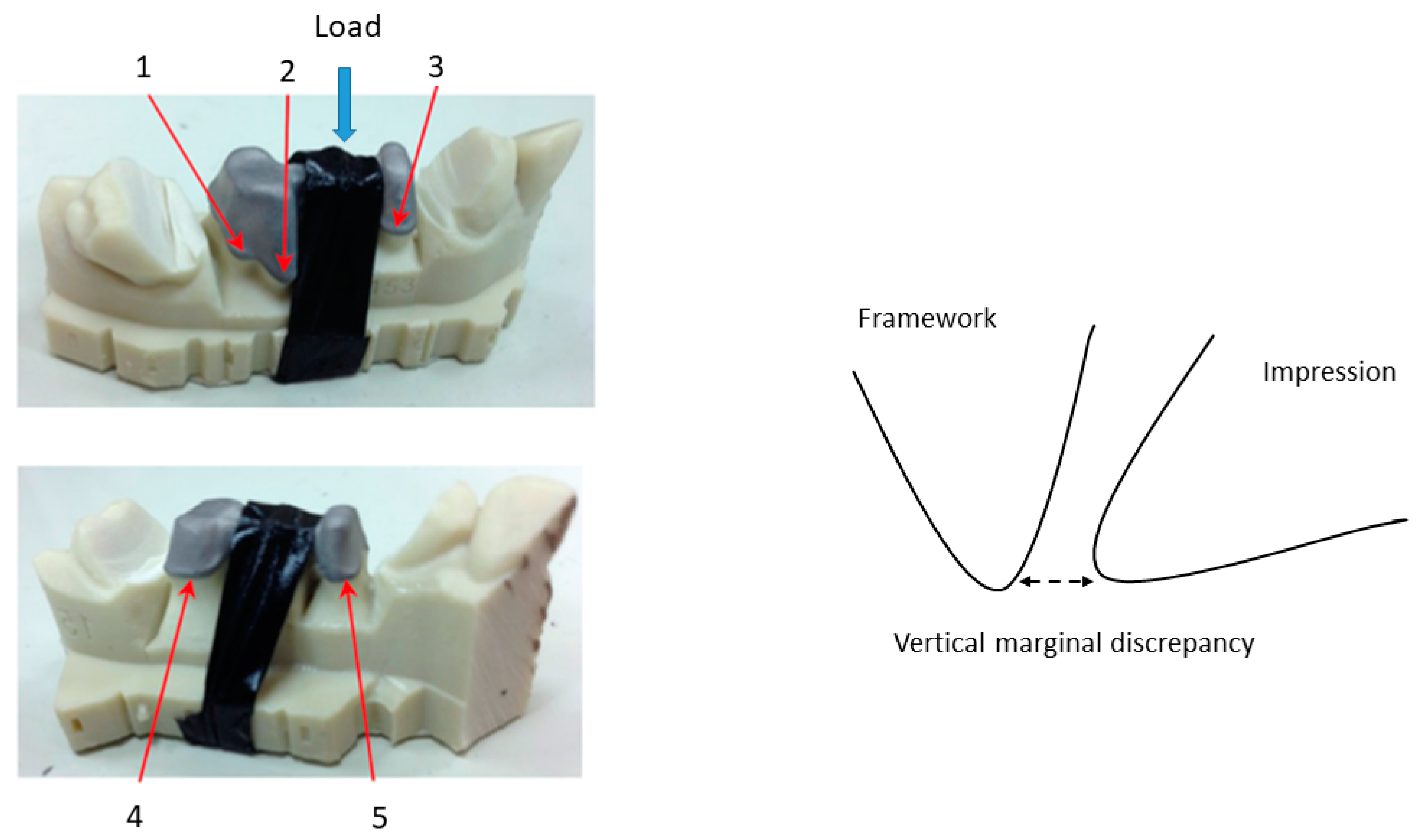
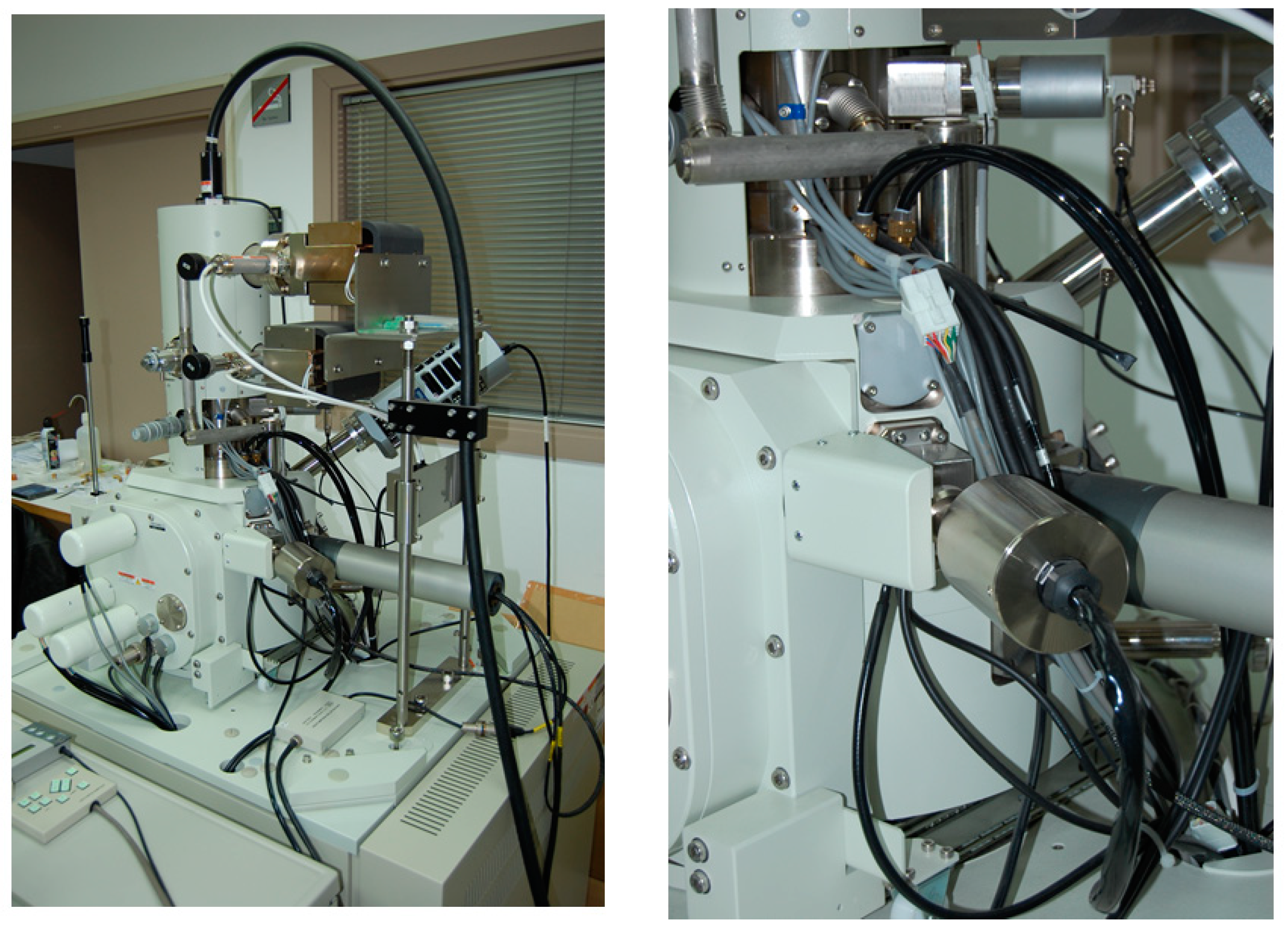
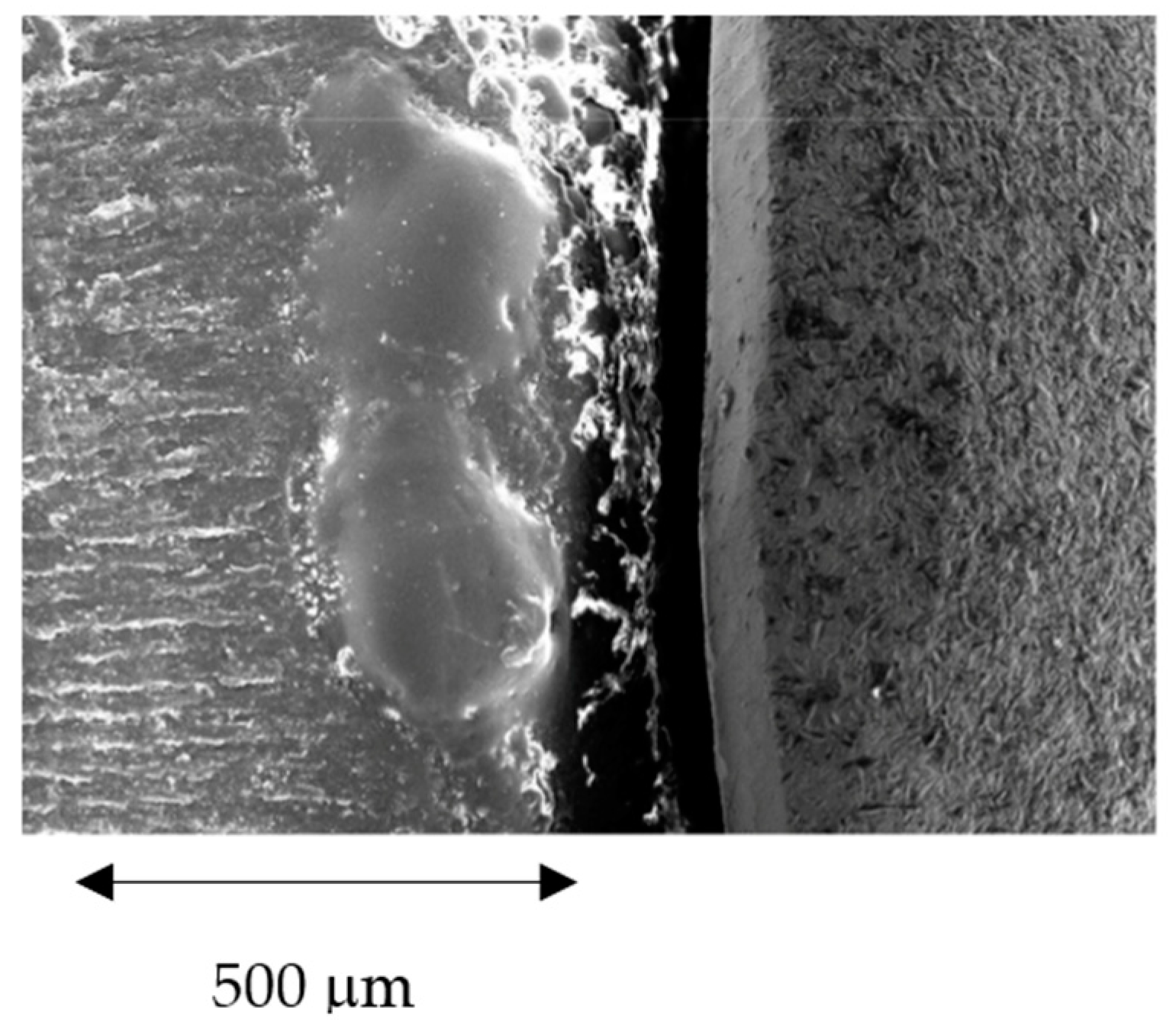
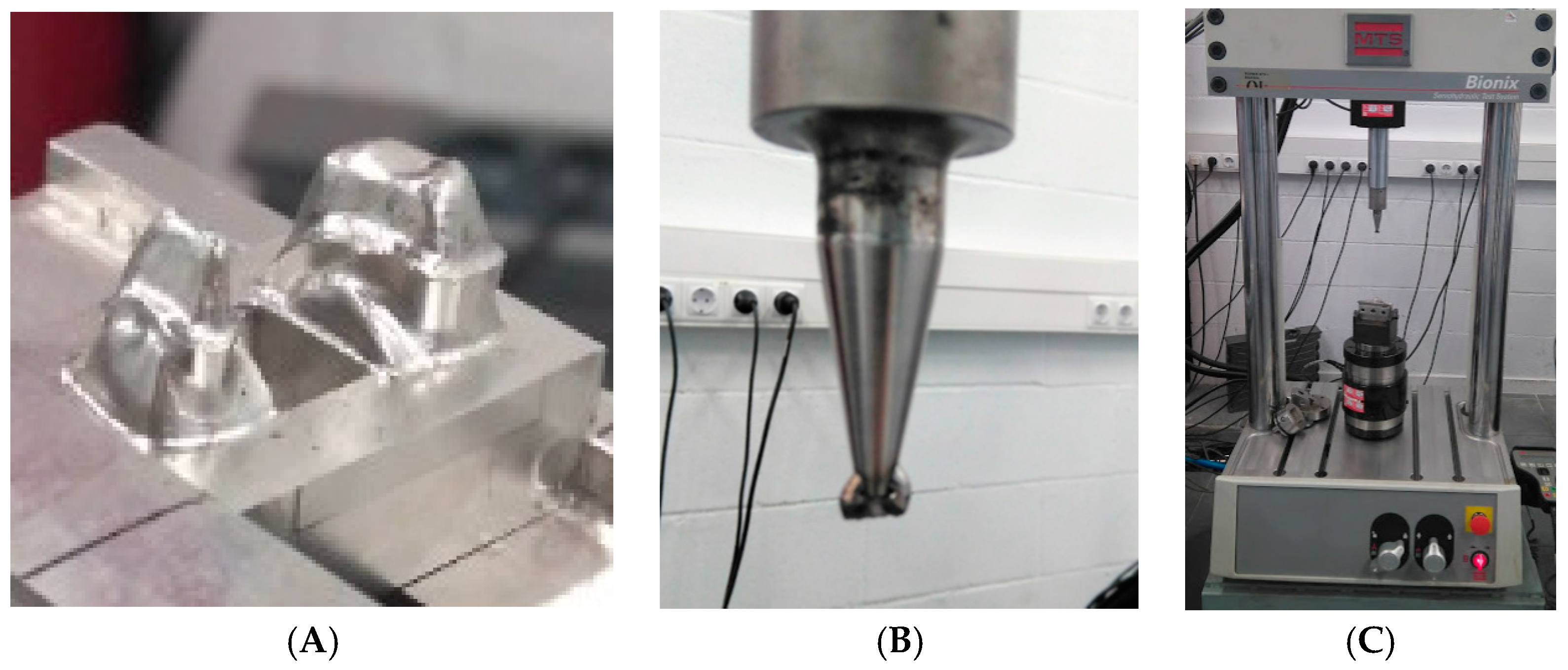
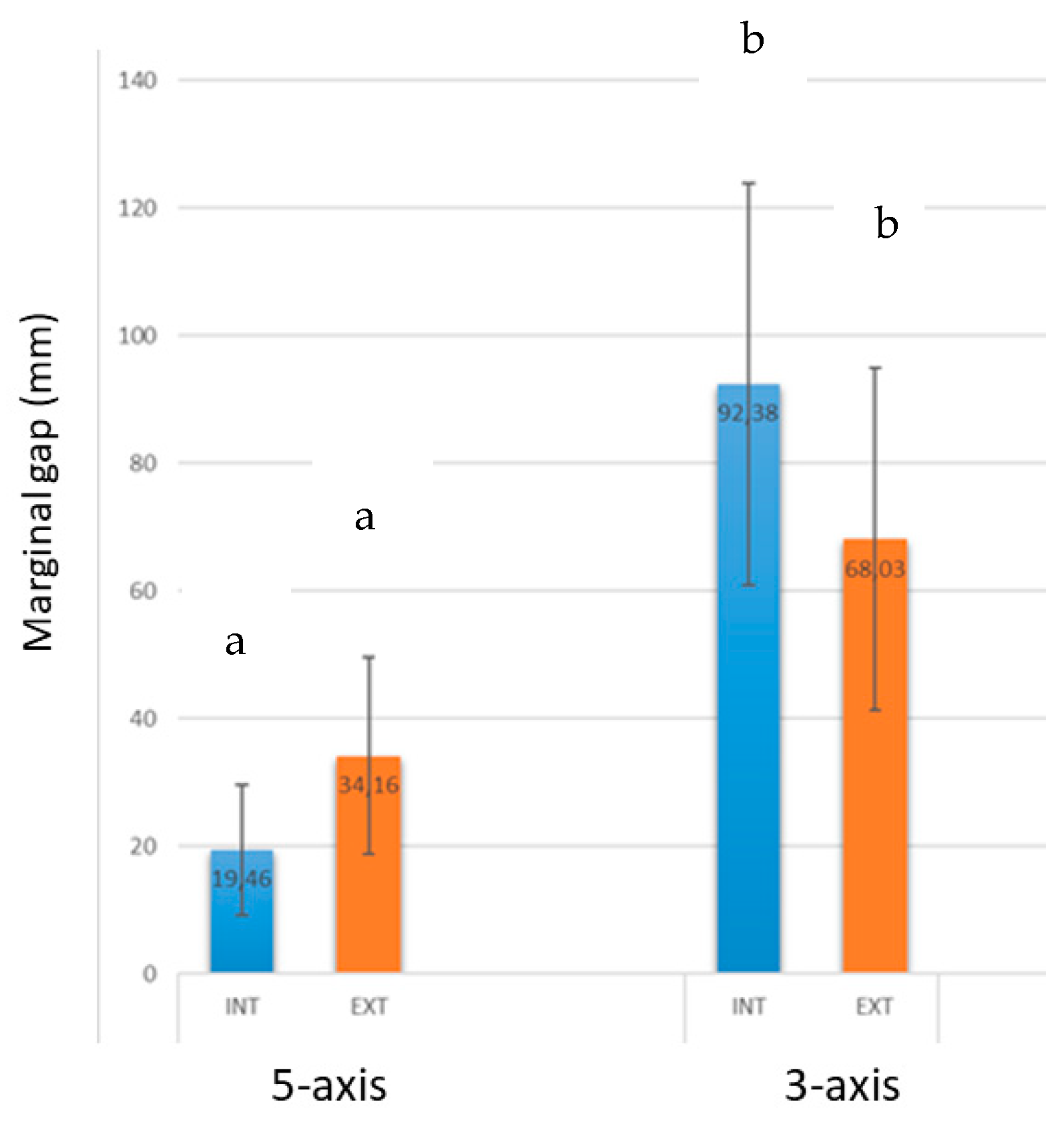
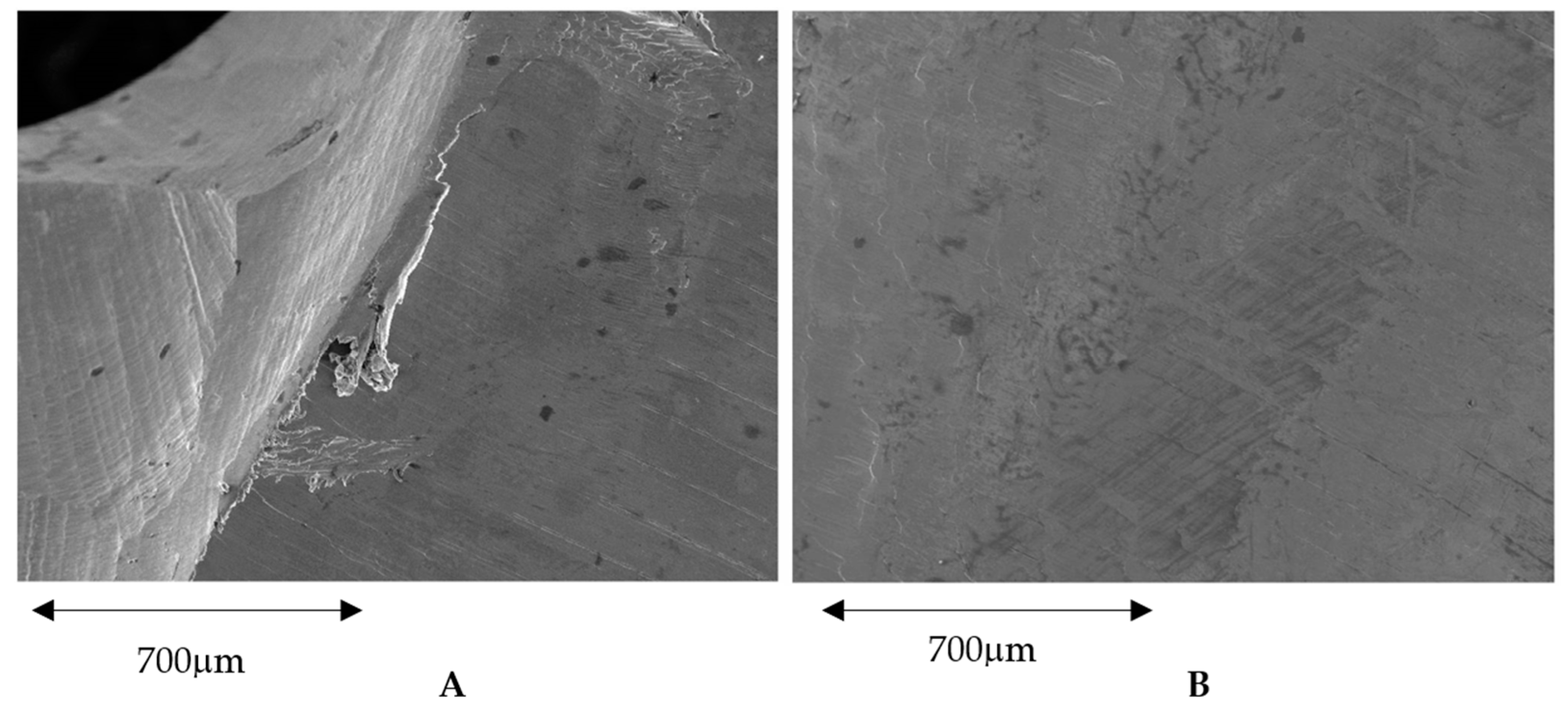
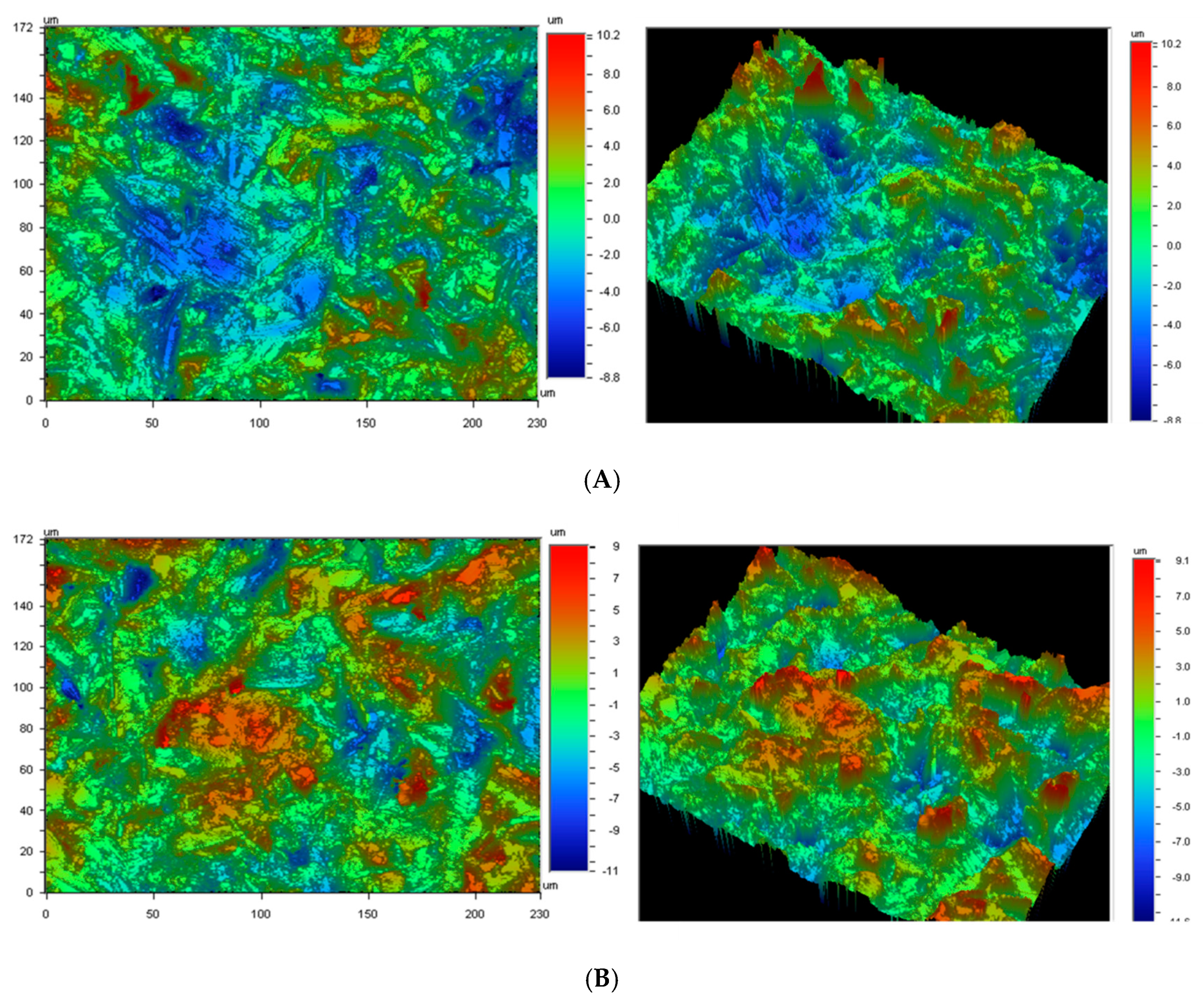

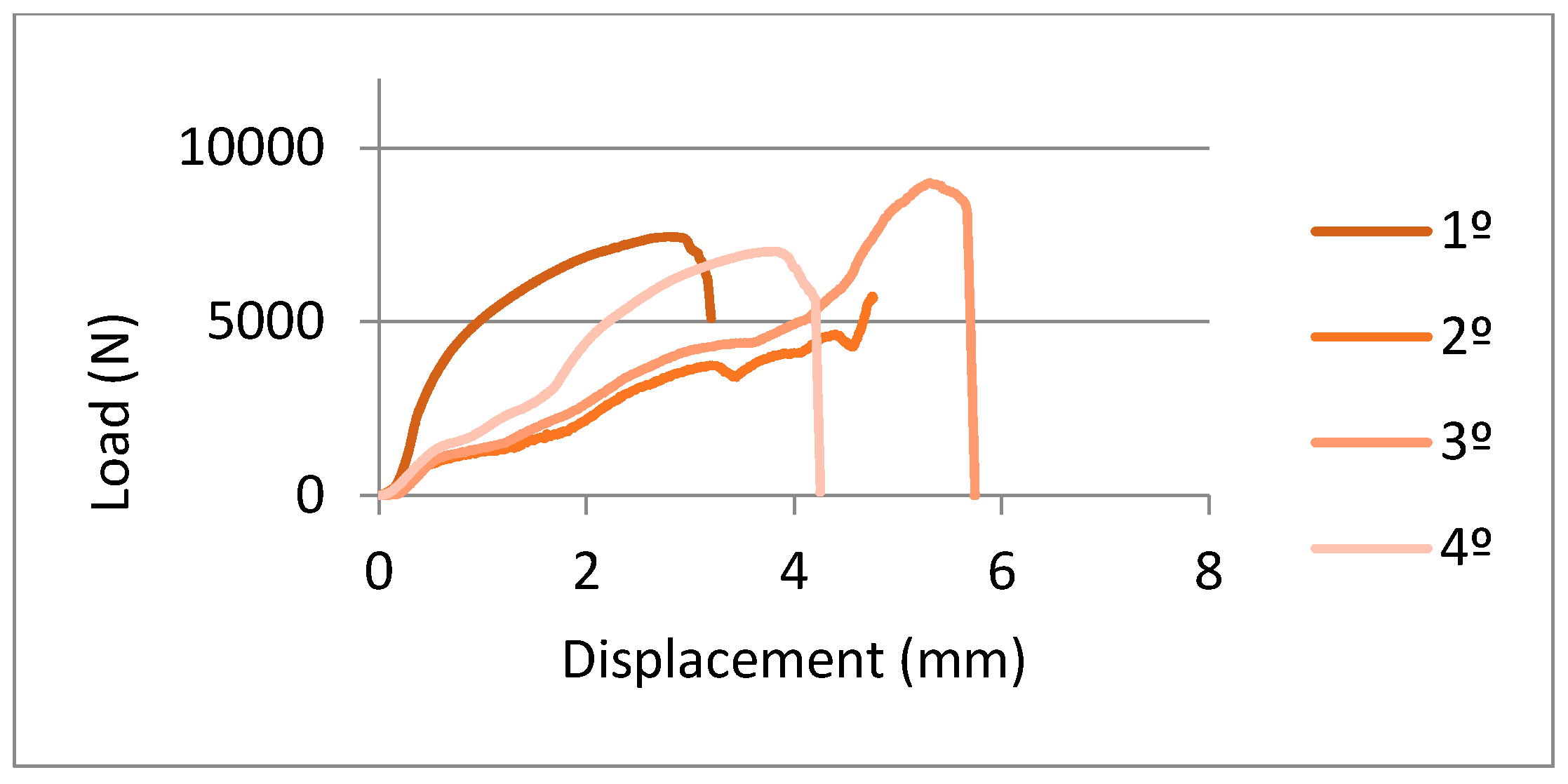

| Co | Cr | W | Si | C | Nb |
|---|---|---|---|---|---|
| 56.53 ± 2.11 | 27.11 ± 1.31 | 9.64 ± 0.79 | 1.27 ± 0.80 | <1% | <0.1% |
| CAD-CAM | Sa (nm) | SA Index Area |
|---|---|---|
| three-axis | 809.3 ± 20.8 | 2.2 ± 0.1 |
| five-axis | 779.3 ± 17.8 | 2.1 ± 0.1 |
© 2020 by the authors. Licensee MDPI, Basel, Switzerland. This article is an open access article distributed under the terms and conditions of the Creative Commons Attribution (CC BY) license (http://creativecommons.org/licenses/by/4.0/).
Share and Cite
Padrós, R.; Giner, L.; Herrero-Climent, M.; Falcao-Costa, C.; Ríos-Santos, J.-V.; Gil, F.J. Influence of the CAD-CAM Systems on the Marginal Accuracy and Mechanical Properties of Dental Restorations. Int. J. Environ. Res. Public Health 2020, 17, 4276. https://doi.org/10.3390/ijerph17124276
Padrós R, Giner L, Herrero-Climent M, Falcao-Costa C, Ríos-Santos J-V, Gil FJ. Influence of the CAD-CAM Systems on the Marginal Accuracy and Mechanical Properties of Dental Restorations. International Journal of Environmental Research and Public Health. 2020; 17(12):4276. https://doi.org/10.3390/ijerph17124276
Chicago/Turabian StylePadrós, Roberto, Luís Giner, Mariano Herrero-Climent, Carlos Falcao-Costa, José-Vicente Ríos-Santos, and Francisco Javier Gil. 2020. "Influence of the CAD-CAM Systems on the Marginal Accuracy and Mechanical Properties of Dental Restorations" International Journal of Environmental Research and Public Health 17, no. 12: 4276. https://doi.org/10.3390/ijerph17124276
APA StylePadrós, R., Giner, L., Herrero-Climent, M., Falcao-Costa, C., Ríos-Santos, J.-V., & Gil, F. J. (2020). Influence of the CAD-CAM Systems on the Marginal Accuracy and Mechanical Properties of Dental Restorations. International Journal of Environmental Research and Public Health, 17(12), 4276. https://doi.org/10.3390/ijerph17124276








